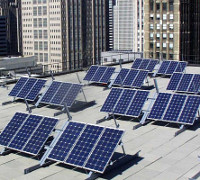To tackle rising power prices and severe power crisis in the Capital city of India, solar energy can be best used in this city which enjoys around 300 sunny days a year
 New Delhi, India’s Capital, is a black-out prone zone. A policy has been initiated for several households and businesses to install solar power plants on the rooftops, replicating a model which sparked huge success in the US and Japan.
New Delhi, India’s Capital, is a black-out prone zone. A policy has been initiated for several households and businesses to install solar power plants on the rooftops, replicating a model which sparked huge success in the US and Japan.
Delhi Electricity Regulatory Commission has announced new regulations for a new net-metering program which credits people for the energy they can’t consume. Whoever is producing solar power on their rooftops can feed the excess power to the grid and earn credits leading to reduction in the next electricity bill. They will be paid by the local distribution utility for remaining credits at the end of the financial year.
The Narendra Modi-led government has pledged to expand the solar industry in India in the form of scattered rooftop installations which made US and Japan one of the biggest solar energy markets in the world. This transition can also prompt Indian government to extend the national solar target to 100GW by 2022, as per Power Minister Piyush Goyal. Last month Goyal said, “We’re looking at going far beyond the National Solar Mission’s 20,000 megawatts by 2022 — that clearly is not Mr. Modi’s vision. The honorable prime minister wants to see much faster growth in the solar sector. He has personally spoken about expanding rooftop rapidly.”
The Delhi policy is following the footsteps of a pilot program which was set up in Gandhinagar where residents lease their rooftops to private solar utilities and get paid Rs 3 for every kilowatt-hour of electricity produced. The regulator in Delhi didn’t reveal the tariff rate for the consumers and it has been only announced that they would be paid “per the rates notified by the commission from time to time.” The problem lies in the fact that, though Delhi has almost 300 sunny days every year, it has very little open space. The new net-metering system helps address the space constraint by urging businesses and homes to utilise their rooftops to tap the solar energy. By 2020, the capital can install 2GW solar power on its roofs. As power prices are uprising, it would become cheaper by 2018 for any residential, industrial or commercial consumer if they consume electricity from solar power and not the grid.







